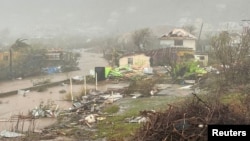Hurricane Beryl was heading toward Jamaica on Tuesday as a powerful cyclone Category 4 storm after hitting smaller islands in the eastern Caribbean, with scientists saying climate change was likely the cause of the storm’s rapid strengthening.
Beryl, unusually early in strength for the current Atlantic season, knocked down power lines and triggered flash flooding. At least three deaths have been reported so far.
As the first hurricane of the 2024 Atlantic season and the earliest storm on record to reach the highest category on the Saffir-Simpson scale, it hit St. Vincent and the Grenadines particularly hard, according to Prime Minister Ralph Gonsalves.
“The hurricane has come and gone, leaving behind immense destruction,” he said. On one island in the Grenadines archipelago, Union, 90% of homes have been “seriously damaged or destroyed,” he added.
The prime minister confirmed one death and said more fatalities could be reported in the coming days.
In a video news conference on Tuesday, Grenada’s Prime Minister Dickon Mitchell highlighted that Carriacou and Petite Martinique, two of the three islands that make up the country, were the hardest hit by the natural disaster.
“The situation is grim. There is no electricity. There is almost complete destruction of houses and buildings,” he said, adding that roads were impassable due to downed power lines and destroyed fuel stations limiting supplies.
Mitchell said at least two deaths were so far attributed to the impact of Beryl.
The hurricane, with maximum sustained winds of 249 kilometers per hour (kph), is currently located about 781 kilometers east-southeast of the Jamaican capital, Kingston, according to a warning from the US National Hurricane Center (CNH) issued on Tuesday.
The agency estimates that the huge weather system is moving west-northwest at a speed of 35 kilometers per hour.
“Beryl is forecast to remain a powerful hurricane as it moves through the Caribbean Sea through the end of this week,” the NHC said in a statement. A hurricane warning is in effect in Jamaica, where Beryl is expected to make landfall on Wednesday.
In Fort-de-France, on the island of Martinique, north of Saint Vincent, a video shared on social media showed heavy flooding in the streets as locals tried to remove debris.
The NHC has also issued a hurricane watch for the southern coast of Haiti, as well as the islands of Grand Cayman, Little Cayman and Cayman Brac.
Weakening is forecast later Tuesday, but Beryl will likely remain a powerful hurricane and is expected to dump 100 to 300 millimeters (4 to 12 inches) of rain across Jamaica and southwestern Haiti through Wednesday night, the NHC forecast said.
According to Christopher Rozoff, a scientist at the National Center for Atmospheric Research in the United States, global warming has contributed to record temperatures in the North Atlantic. According to Rozoff, warmer waters cause more evaporation, which favors the formation of more intense hurricanes with stronger winds.
Beryl went from Category 1 to Category 4 in less than 10 hours, according to Andra Garner, a meteorologist at Rowan University. It was the fastest strengthening ever recorded before September, the peak of the Atlantic hurricane season, she added.
Beryl is also expected to approach Mexico’s Yucatan Peninsula on Thursday night, home to popular beach resorts.
Connect with the Voice of America! Subscribe to our channels Youtube, WhatsApp and to newsletter. Turn on notifications and follow us on Facebook, X and Instagram.
















Add Comment